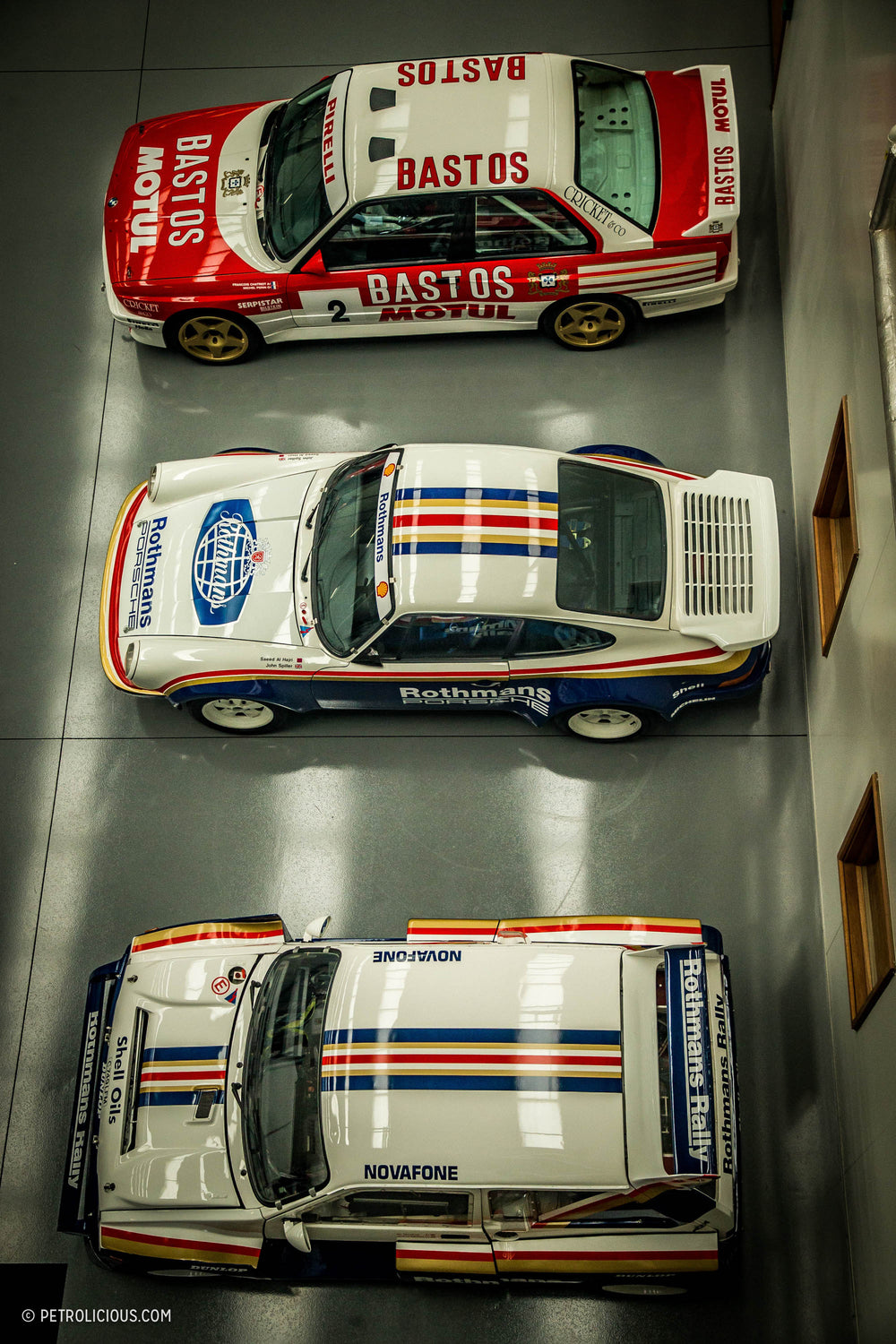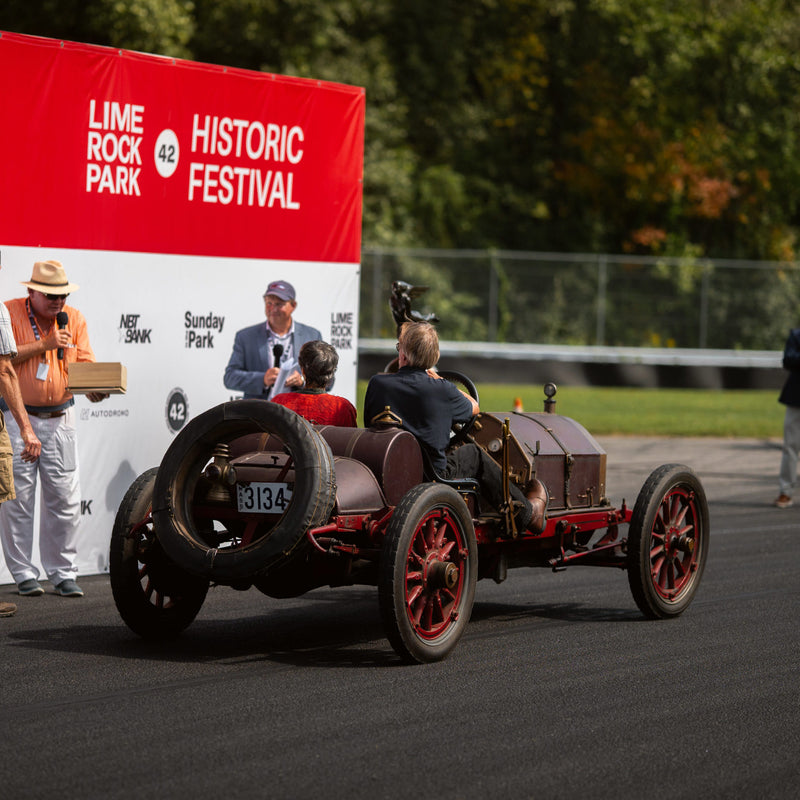There are many independent race car preparation companies, but almost none have the depth of experience or success in such a sheer breadth of motorsport variety as Prodrive. The Banbury-based outfit’s decades of success ranges from not-so-humble beginnings running Porsche’s works SC/RS program, to the BTCC, the WRC, class-winning Le Mans cars, to their current focus of taking on Aston Martin's GT racing aspirations. If they were selling t-shirts they would say “Been there, done that.” I recently found myself in the area and was allowed to wander around the headquarters of this fantastic company.
Visitor parking, check. Revolving doors, check. Receptionist desk with aroma of coffee providing the welcoming area, check. Le Mans LM GTE Pro class-winning Aston Martin Vantage blocking the way in? Check. Despite their illustrious history, literally dozens of world championships in many different disciplines, the 2017 Le Mans victory is the highlight of David Richards' enterprise. So far.




But before they got to Le Sarthe's winner’s circle, it was the WRC that Prodrive made their name in. Next to the be-winged Aston is a car that conjures plenty of emotion on its own; the sadly departed Richard Burns 2000 Safari Rally Subaru Impreza. On jacked-up suspension to cope with the brutal African roads and fitted with a snorkel so the car could breathe while partially submerged in mud and river crossings, Burns beat rallying legend Juha Kankkunen by four and half minutes over the 1,600 miles of competitive rallying. The following year, he would go on to win the WRC drivers’ title.


The Mini John Cooper Works car nearby was campaigned in 2011, and was Prodrive’s attempt to get back to the top of the WRC after Subaru had withdrawn their works team at the end of 2008. It was a beautiful looking car, but it never came close to repeating the glory of the Subaru years. Its best results came in 2011 when Spaniard Dani Sordo took 3rd in Germany and 2nd in France, just six seconds behind Sébastien Ogier, the man with the second most WRC season trophies of all time.

I then head through the doors to the workshop proper. With no guide, nor guards on duty, I was let inside free to wander around this hallowed place by myself. There is as of yet no standalone museum for the classic cars that Prodrive used to race with in years gone by, but to keep them in absolute top shape some are brought in here every now and then to be given a thorough check over—thankfully there were some stunning and iconic cars waiting to have some work done during my visit.
I grew up in the 1980s, standing in Welsh forests or else watching videos of British rallying on tape and broadcast, so looking at some of the iconic examples in the metal (and fiberglass) was a little overwhelming. Andy Brown, manager of the heritage collection, came over to help me get my bearings. Andy was at Prodrive in its formative years when it was just half a dozen people, a rather far cry from the 500 that are currently employed under the name. After a few years, he left in the mid-1990s, but seeing as he built the cars in the first place, he was the perfect man to be brought in to look after the classics today. Now with the enviable job of managing the collection, he suggested we start chronologically, with the Rothmans-liveried 911 SC/RS that started it all.


Company founder David Richards knew plenty about rallying before Prodrive came to be, seeing as he was already a world champion co-driver during the time he read Ari Vatanen's pace notes during his championship-winning 1981 season. He then helped out with Rothmans’ rallying efforts before he won the contract to run Porsche's exploits with the SC/RS, which was supposed to be a stop gap to get the Rothmans sponsorship before the 959 was ready. The program included the European Rally Championship, the Middle East Rally Championship, and selected WRC events. And he didn't start by doing anything by halves either. Henri Toivonen, Jimmy McRae, and Juha Kankkunen—all massive names in the world of rallying of course—each had turns behind the wheel of the glorious cars that Richards ran, and Toivonen finished 2nd in the 1984 European Rally Championship after taking three wins.
The greatest early success however came in the hands of Qatari Saeed Al-Hajri who guided the Porsche through the deserts of the grueling Middle East Rally Championship, winning three out of the six rounds in both 1984 and ’85, taking the title in both years. Beforehand, he made some Prodrive history when he entered the 1984 Acropolis Rally, marking the company’s first-ever WRC event.



In rallying the year 1986 is synonymous with the demise of the legendary Group B monsters, and it was also when Prodrive took on the MG Metro 6R4. With Jimmy McRae at the wheel won the Ulster rally on the way to getting 4th in the championship, and 8th on the last running of the Group B cars in the WRC at the RAC Rally. The naturally-aspirated, UK-made Metro, as outlandish as it looks, wasn't really a match on the international scene for the turbocharged supercars from Peugeot, Lancia, Ford, and Audi.


The burgeoning company was still a few years away from entering the top level of the WRC then, but before they ascended the heights of success with Subaru they competed with BMWs, both racing them in the BTCC (to several class and overall championship wins) and rallying for European tarmac-based events. In 1987 the Group A rules meant that only slightly modified, series-produced cars were eligible to compete, and Bernard Béguin in a Prodrive-prepped BMW E30 M3 had a dominant drive to beat the might of the works Lancia and Ford teams when he won the Tour de Corse to claim Prodrive's first, of a great many to come, WRC wins.


In 1988 Patrick Snijers won the Belgian rally championship and took 2nd in the European one, while in sister cars Francois Chatriot and Marc Duez won the French and Belgian championships, respectively. The one on display in the gallery is Chatriot's 1990 French Tarmac Championship-winning car. In the same year, in the bigger ERC, he won two rallies on his way to a 5th in the season.
Now we’re upto the earliest of the Subarus, the Legacy from 1992. And written on the side a legendary name, that of one of the nicest and most genuine people in the whole of motorsport; Ari Vatanen. Almost killed in a horrific accident in 1985, he took on the 1987 Paris-Dakar in a triumphant return to the sport but never won again in the WRC... although he did come close. With this car, he finished a fine 4th at the 1992 1000 Lakes Rally.



The car has been in the Prodrive collection for a long time now, and Brown is working his way through it currently, giving it a full systems check that includes laboriously inspecting every component in the electrical system, taking the gearbox out to make sure everything is perfect, the clutch as well, and making sure that nothing in the fuel system has perished. One of the last jobs will be making a new set of mud flaps have somehow gone missing sometime in the last three-odd decades.
There's no car that either evokes such emotion, or represents the height of Prodrive's success, though, than Colin McRae's 555 Impreza. With the number 1 on the door, it's not his championship-winning car, as that particular one is owned by the McRae family, but it still carries plenty of figurative weight. The 1996 season was dominated by Tommi Mäkinen and his Mitsu, and while McRae's year was marred by unreliability, he still managed to finish 2nd with three wins in the season, the last being at the Catalunya Rally, the stickers for which are still on this Subaru. The boxer engine was out for refurbishment at the time of my visit, but there are no big plans to drive it hard anywhere regardless, just some press and client promotion work. With Richard Burns and then Petter Solberg, Prodrive cars were used to achieve three drivers’ crowns, and just as importantly the manufacturers’ titles for three seasons in a row: 1995, ’96, and '97.






Moving up to the 21st century, on the other side of the workshop sat Glenn Seton's 2004 BA Falcon from the Australian V8 Supercars Championship when Prodive ran Ford Performance Racing. With 15th overall in the championship, this was actually their least successful car of their antipodean adventures, as they finished races in the runner's up spot four times, but it is still an impressive sight as there can't be that many V8 Supercars living way over in Europe. The car is not just huge, it's comically big, and has just recently arrived for Brown to start checking it over.

Behind it, dwarfed behind it, is another very interesting car: the P2. An experiment from 2006 to show that Prodrive was capable of building a full car up rather than just preparing existing ones, it’s still far from a normal car. Based on a tiny Subaru R1 platform, the body was designed by Peter Stevens of McLaren fame, but it's the drivetrain that makes it really special. Full of WRC-based trickery such as active diffs and an anti-lag turbo system, and powered by a 345bhp Impreza engine, on the Top Gear Power Lap driven by the Stig back in the day it not only beat such cars as the Aston Martin Vanquish, Audi R8, and BMW M5, it also made Jeremy Clarkson throw up, which gives it a few extra points in my book!




That was what was currently in the workshop from the heritage collection, but there was far more activity going on nearby, as an entire production line of GT3 and GT4 Aston Martin Vantages being built up from bare shells into track ready race cars took up most of the floor space. Only the bare shells come from Aston, and Prodrive does absolutely everything else to get them ready for the track. And it's a real production line too, as an incredible 60 cars will be made in 2019.




On the other side of the petition is more impressive Aston content. Seeing the glorious works WEC cars partially stripped for maintenance is not something you get to see every day. While I was there they were being made ready for the biggest GT race of them all; Le Mans, which begins this Saturday with what’s surely going to be another competitive year for the GTE Pro class that these compete in. Prodrive's cars will be there again against the might of Porsche, Ford, BMW, Chevrolet, and Ferrari, hoping to repeat 2017's success when Darren Turner, Jonathan Adam, and Daniel Serra won the GTE Pro class in the final laps against Chevrolet.



Whatever the results are on Sunday afternoon in France, with some 1,200 events entered over the last 35 years, which include 500 podiums and 300 wins, Prodrive have long been at the top of their game.





















































